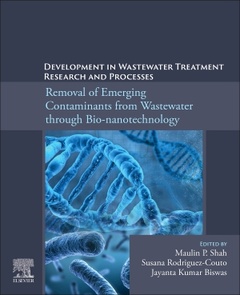Description
Development in Wastewater Treatment Research and Processes
Removal of Emerging Contaminants from Wastewater through Bio-nanotechnology
Coordinators: Rodriguez-Couto Susana, Rodriguez-Couto Susana, Shah Maulin P, Shah Maulin P., Biswas Jayanta Kumar, Biswas Jayanta Kumar
Language: English
Subjects for Development in Wastewater Treatment Research and Processes:
Keywords
Emerging contaminants; PPCPs; EDCs; Nanomaterials; Nanoadsorption; Nanoadsorbents; Advanced oxidation process (AOP); Photocatalytic oxidation; Hydroxyl radicals (°OHs); Sulfate radicals (SO4-); Microfiber; Pollution; Membrane bioreactor (MBR); Treatment; Pharmaceuticals; Endocrine disruptors; Personal care products; Adsorbents; Membrane fouling; Sludge retention times; Wastewater; Nanotechnology; Waste water; Nanoremediation; Nanosorbents; Nanocatalysts; Ozonation; O3 treatment; Ozone bases water treatment; Water treatment with ozone; Ozone disinfection; Bioremediation; Consortium; Constructed wetland; Dyes; Textile effluent; Phytoremediation; Nanobiotechnology; Wastewater treatment; Green chemistry; Nano-bio-factories; Pollutants; Biological entities; Mechanism of synthesis; Nanofiltration; Advanced oxidation process; Pharmaceutical contaminants; Adsorption technology; Biochar; Hazardous chemicals; Pesticides; Remediation; Sand filter; Waste stabilization ponds; Aquatic treatment; Nanoparticles; Pathogenic Bacteria
722 p. · 19x23.4 cm · Paperback
Description
/li>Contents
/li>Biography
/li>Comment
/li>
Removal of Emerging Contaminants from Wastewater through Bio-nanotechnology showcases profiles of the nonregulated contaminants termed as ?emerging contaminants, which comprise industrial and household persistent toxic chemicals, pharmaceuticals and personal care products (PPCPs), pesticides, surfactants and surfactant residues, plasticizers and industrial additives, manufactured nanomaterials and nanoparticles, microplastics, etc. that are used extensively in everyday life. The occurrence of ?emerging contaminants in wastewater, and their behavior during wastewater treatment and production of drinking water are key issues in the reuse and recycling of water resources.
This book focuses on the exploitation of Nano-biotechnology inclusive of the state-of-the-art remediate strategies to degrade/detoxify/stabilize toxic and hazardous contaminants and restore contaminated sites, which is not as comprehensively discussed in the existing titles on similar topics available in the global market. In addition, it discusses the potential environmental and health hazards and ecotoxicity associated with the widespread distribution of emerging contaminants in the water bodies. It also considers the life cycle assessment (LCA) of emerging (micro)-pollutants with suitable case studies from various industrial sources.
1. Nanoadsorbents for scavenging emerging contaminants from wastewater 2. Treatment aspect of an emerging pollutant from Pharmaceutical industries using advanced oxidation process: past, current, and future trends 3. Membrane bioreactor (MBR) as an advanced wastewater treatment technology for removal of synthetic microplastics 4. Strategies to cope with the emerging waste water contaminants through adsorption regimes 5. Performances of membrane bioreactor technology for treating domestic wastewater operated at different sludge retention time 6. Advances in nanotechnologies of waste water treatment: strategies and emerging opportunities 7. Water and wastewater treatment through ozone-based technologies 8. Constructed wetland: a promising technology for the treatment of hazardous textile dyes and effluent 9. Biogenic nanomaterials: synthesis, characteristics, and recent trends in combating hazardous pollutants (an arising scientific horizon) 10. Removal of emerging contaminants from pharmaceutical wastewater through application of bionanotechnology 11. Recent advances in pesticides removal using agroindustry based biochar 12. Bioremediation – the natural solution 13. Detection and removal of pathogenic bacteria from wastewater using various nanoparticles 14. Application of TiO2 photocatalysts hybridized with carbonaceous for degradation of pharmaceuticals 15. Moving bed biofilm reactor- (MBBR-) based advanced wastewater treatment technology for the removal of emerging contaminants 16. An application of bionanotechnology in removal of emerging contaminants from pharmaceutical waste 17. Removal of emerging contaminants in water Treatment by an application of nanofiltration and reverse psmosis 18. Membrane bioreactor (MBR) as an advanced wastewater treatment technology 19. Removal of pesticides from water and wastewater by solar-driven photocatalysis 20. Recent applications, reaction mechanism, and future perspective of hybrid ozonation process for water and wastewater treatment 21. Removal of emerging contaminants from pharmaceutical waste through application of bio nanotechnology 22. Antimicrobial activities of different nanoparticles concerning to wastewater treatment 23. Application of nanomaterial in wastewater treatment: recent advances and future perspective 24. Photocatalytic removal of emerging contaminants in water and wastewater treatments: a review 25. Biologically synthesized nanoparticles for dye removal 26. Removal of emerging contaminants in water treatment by nanofiltration and reserve osmosis 27. Hybrid bioreactor in combination with ozone-based technologies for industrial wastewater treatment 28. Metal organic frameworks (MOFs) in aiding water purification from emerging and ionic contaminants 29. Removal of emerging contaminants from wastewater through bionanotechnology
Dr. Maulin P. Shah is Chief Scientist and Head of the Industrial Waste Water Research Lab, Division of Applied and Environmental Microbiology Lab at Enviro Technology Ltd., Ankleshwar, Gujarat, India. His work focuses on the impact of industrial pollution on the microbial diversity of wastewater following cultivation-dependent and cultivation-independent analysis. His major work involves isolation, screening, identification, and genetically engineering high-impact microbes for the degradation of hazardous materials. His research interests include biological wastewater treatment, environmental microbiology, biodegradation, bioremediation, and phytoremediation of environmental pollutants from industrial wa
- Provides natural and ecofriendly solutions to deal with the problem of pollution
- Details underlying mechanisms of nanotechnology-associated microbes for the removal of emerging contaminants
- Describes numerous successful field studies on the application of bio-nanotechnology for eco-restoration of contaminated sites
- Presents recent advances and challenges in bio-nanotechnology research and applications for sustainable development
- Provides authoritative contributions on the diverse aspects of bio-nanotechnology by world’s leading experts




